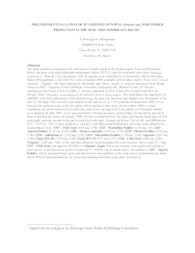Preliminary evaluation of 30 varieties of nopal (Opuntia spp.) for fodder production in the semi-arid northeast, Brazil.
Preliminary evaluation of 30 varieties of nopal (Opuntia spp.) for fodder production in the semi-arid northeast, Brazil.
Autoria: ALBUQUERQUE, S. G. de
Resumo: The main problems associated with cultivation of fodder nopal in the Sertão region, Semi-arid Northeast, Brazil, are poor soils, high minimum temperature (above 20.5o C), and the armoured scale insect (Diaspis echinocacti - Bouchè). An experiment with 30 varieties was established in in December 1994 at Petrolina, State of Pernambuco, a site with 552.2 mm of rainfall (80% available in December-April). There were: 3 local varieties:- ‘Gigante’ (the most cultivated), ‘Redonda’ and ‘Doce’, nopal; .6 varieties introduced from South Africa in 1982 - Algerian, Corfu, Direkteur, Fusicaulis, Guayaquil and Skinners Court; 19 varieties introduced from Texas (USA) in 1986,; 2 varieties furnished by IPA: Clone IPA-19 and Clone IPA-20. Except ‘Doce’ (Nopalea cochenillifera), all varieties were O. ficus-indica. The experiment was organized, in a RCBD, with four replications. After disk plowing, the area was furrowed and manure was distributed, at the rate of 2.86 kg/m. The varieties were planted at the density of ca. 7,143 pads/ha. In September 1995, it was detected the armored scale in the first plots, which spread to other plots. In November 1996, a visual evaluation was performed by two technicians, and scores varying from 0 (no attack) to 10 (highest attack) were adopted. In May 1997, a test was performed with four products, each product for one block, and all of them controlled the insect. In January 1998, the first triennial harvest was done, leaving the basal-pad, all first order pads, and one second order pad in each first order pad. Average yield was 2.46 ± 1.86 ton DM/ha/year (CV = 75.5 %). The 12 most productive varieties, with DM production/ha/year and scale insect attack level n parenthesis were: 1317 - Chile fruit (6.07 ton; 1.50); 1327 - Marmillon Fodder (4.18 ton; 2.0); 1267 - Algeria Fodder (4.14 ton; 0.50); 1294 - Mexico vegetable (4.02 ton; 4.25); 1278 - Mexico Fodder (4.02 ton; 7.00); 1258 - Additional cv. (3.92 ton; 3.75); 1311 - Marmillon Fodder (3.70 ton; 1.50); Algerian (3.65 ton; 2.00); Clone IPA-20 (3.55 ton; 2.50); Clone IPA-19 (3.37 ton; 2.75); 1316 - Chile fruit (2.89 ton; 2.50); ‘Gigante’ (2.85 ton; 7.00). Even with that difference in performance between varieties, due to high CV, only 1317 - Chile fruit was superior (P<0.05) to ‘Gigante’ nopal. The local varieties were highly susceptible to scale insect, a trait that needs further research,(CV = 89.0%, due to block effect). In contrast to 1267 - Algeria Fodder, which, presented high yield, and showed low susceptibility to the scale insect, maintaining the stand above 90% of initial population, six years after planting and three years after first harvest.
Ano de publicação: 2004
Tipo de publicação: Resumo em anais e proceedings
Unidade: Embrapa Semiárido
Palavras-chave: Forragem, Nordeste, Opuntia, Palma, Palma Forrageira, Produção, Região Semi-árida
Observações
1 - Por padrão são exibidas publicações dos últimos 20 anos. Para encontrar publicações mais antigas, configure o filtro ano de publicação, colocando o ano a partir do qual você deseja encontrar publicações. O filtro está na coluna da esquerda na busca acima.
2 - Para ler algumas publicações da Embrapa (apenas as que estão em formato ePub), é necessário ter, no celular ou computador, um desses softwares gratuitos. Sistemas Android: Google Play Livros; IOS: iBooks; Windows e Linux: software Calibre.
Acesse outras publicações
Acesse a Base de Dados da Pesquisa Agropecuária (BDPA) para consultar o acervo completo das bibliotecas da Embrapa.

